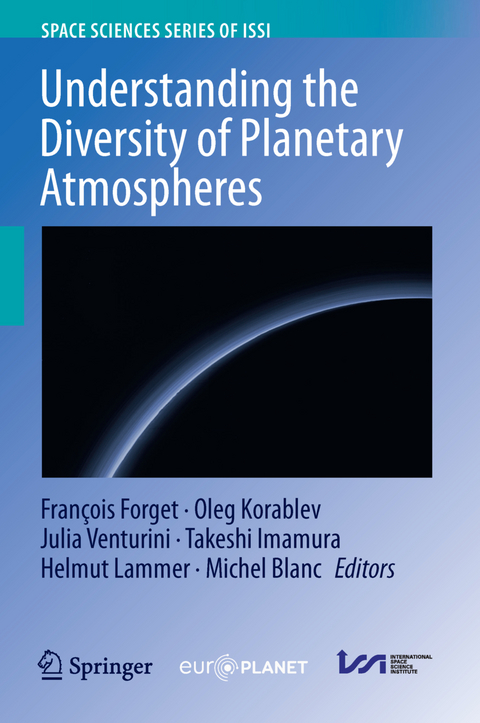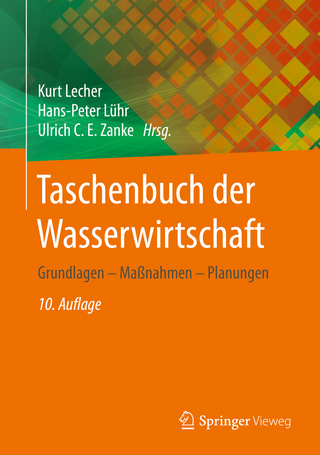
Understanding the Diversity of Planetary Atmospheres
Springer (Verlag)
978-94-024-2128-6 (ISBN)
This book brings together 15 review chapters that study and provide up-to-date information on the physical and chemical processes that control the nature of atmospheres. It identifies commonalities between various solar system atmospheres, analyzes the dynamic processes behind different atmospheric circulation regimes, and outlines key questions remaining in solar system science.
Through this comprehensive overview, the volume will help researchers understand the possible nature of the exo-atmospheres to be discovered in the coming decades thanks to upcoming new generations of telescopes.
Previously published in Space Science Reviews in the Topical Collection "Understanding the Diversity of Planetary Atmospheres”
François Forget is a CNRS senior research scientist in Paris, where he studies planetary atmospheres in the solar system and around other stars. For his research, he combines numerical modeling and analysis of space observation. With his team he has developed climate models designed to simulate the climate on any planet that one can imagine. He has been involved in several space exploration missions such as Mars Express, New Horizons, Mars Reconnaissance Orbiter, Trace Gas orbiter, Insight, etc. He is a member of the French academy of sciences and recipient of the European Geophysical Union David Bates Medal. Oleg Korablev graduated from Moscow State University (Physics) in 1985. Since then, he has worked in in Space Research Institute (IKI) in Moscow, from an engineer to head of department and deputy director. He has completed his PhD in 1992 and habilitation – in 2003. From 1997 to the mid-2000ies, he worked part-time in Service d'Aeronomie in France (LATMOS at present). Now he occupies the position of a leading researcher in IKI. He contributed to several space projects such as VeGa, Phobos-88, Mars-96, Mars Express, Venus Express, ExoMars, and others. He was the PI of multiple instruments to study planetary atmospheres and co-authored discovery papers dedicated to Mars' atmosphere. In 2016 he was elected to Russian Academy of Science (RAS). He chaired Science Commission B (planets) in COSPAR (2012-2020); heads the Space Council, RAS section on Solar system planets. Julia Venturini is an Uruguayan astrophysicist working on Planet Formation Theory. She moved to Switzerland in 2012 to do her PhD at the University of Bern and has lived in Switzerland since then. She has contrbuted to the understanding of the formation of a variety of planets, ranging from super-Earths and mini-Neptunes to Jupiter. She has recently proposed that the so-called ‘radius valley’ in the distribution of exoplanets’ size is an imprint left from the formation stage, where rocky and icy cores grow in a different mode due to the different properties of rocky versus icy pebbles. Takeshi Imamura is studying planetary atmospheres with emphasis on atmospheric dynamics and cloud processes. He has been working on radio occultation observations of the solar system bodies including the moon, Venus, Mars and the sun. He has been the Project Scientist of JAXA’s Venus mission Akatsuki till 2016. Helmut Lammer works at the Space Research Institute of the Austrian Academy of Sciences in Graz. His main scientific expertise is related to comparative planetology with a focus on comparative Aeronomy between Solar System and exoplanets, their origin, the escape and evolution of planetary atmospheres and water inventories and the implications for habitability. He was and is involved in several space missions (e.g., COROT, BepiColombo, JUICE as a Co-I). He was involved in ESAs Terrestrial Exoplanet Science Advisory Team and was member of ESAs Solar System Working Group, coordinated the Europlanet EU-FP7 project Networking Activity Working Group on Exoplanets and is involved in international projects related to atmosphere evolution and habitability implications as well as currently studied exoplanet projects such as CHEOPS and PLATO. Prof. Michel Blanc is a planetary scientist working at IRAP, Toulouse, France. His research focuses on giant planets systems, the comparative study of Planetary Systems and planetary magnetospheres. He has been the first coordinator of Europlanet from 2005 to 2012, an Interdisciplinary Scientist on the Cassini-Huygens mission, the initiator of the Laplace mission proposal to ESA which led to the selection of ESA’s JUICE mission, and is currently a co-Investigator on NASA’s Juno mission. He has published about 200 articles in peer-reviewed international journals. He is a member of the Air and Space Academy, ofthe International Academy of Astronautics, and of the Academia Europaea, and currently leads the “Planetary Exploration, Horizon 2061” foresight exercise.
1. In Dedication to Adam P. Showman.- 2.Preface: Understanding the Diversity of Planetary Atmosphere- 3. Setting the Stage: Planet Formation and Volatile Delivery.- 4. The Diverse Planetary Ingassing/Outgassing Paths Produced over Billions of Years of Magmatic Activity.- 5. The Diversity of Planetary Atmospheric Chemistry.- 6. Do Intrinsic Magnetic Fields Protect Planetary Atmospheres from Stellar Winds?.- 7. Did Mars Possess a Dense Atmosphere During the First ∼400 Million Years?.- 8. How Well Do We Understand the Belt/Zone Circulation of Giant Planet Atmospheres?.- 9. Is the Faint Young Sun Problem for Earth Solved?.- 10.Superrotation in Planetary Atmospheres.- 11. Comparison of the Deep Atmospheric Dynamics of Jupiter and Saturn in Light of the Juno and Cassini Gravity Measurements.- 12. Atmospheric Dynamics of Hot Giant Planets and Brown Dwarfs 13. Possible Atmospheric Diversity of Low Mass Exoplanets – Some Central Aspects.- 14. Hydrogen Dominated Atmospheres on Terrestrial Mass Planets: Evidence, Origin and Evolution.- 15. A Review of Possible Planetary Atmospheres in the TRAPPIST-1 System.- 16. Outstanding Challenges of Exoplanet Atmospheric Retrievals.- 17. Future Missions to the Giant Planets that Can Advance Atmospheric Science Objectives.
“This book does live up to its title on diversity of planetary atmospheres, giving a useful overview of the state of the art of every aspect — from origin and loss of atmospheres to their weather systems and how best to study them. … A strength of this volume is that the book is rich in helpful graphics and diagrams that illustrate the many interwoven processes at work in this complex and fascinating topic.” (Karen Aplin, The Observatory, Vol. 143 (1292), February, 2023)
| Erscheinungsdatum | 07.09.2022 |
|---|---|
| Reihe/Serie | Space Sciences Series of ISSI ; 81 |
| Zusatzinfo | 155 Illustrations, color; 9 Illustrations, black and white; VI, 591 p. 164 illus., 155 illus. in color. |
| Verlagsort | Dordrecht |
| Sprache | englisch |
| Original-Titel | Understanding the Diversity of Planetary Atmospheres |
| Maße | 155 x 235 mm |
| Themenwelt | Naturwissenschaften ► Chemie |
| Naturwissenschaften ► Geowissenschaften ► Meteorologie / Klimatologie | |
| Naturwissenschaften ► Physik / Astronomie ► Astronomie / Astrophysik | |
| Schlagworte | atmosphere superrotation • exo-atmospheres • exoplanetary atmosphere composition • faint young Sun paradox • giant planet atmospheric circulation • hydrogen atmosphere on terrestrial planet • Jupiter atmospheric dynamics • magnetic fields and atmospheric escape • Mars atmospheric dynamics • planetary atmospheres and stellar winds • planetary atmospheric chemistry • planetary ingassing and outgassing • Saturn atmospheric dynamics • solar system planet atmospheres • Trappist 1 planet atmosphere |
| ISBN-10 | 94-024-2128-9 / 9402421289 |
| ISBN-13 | 978-94-024-2128-6 / 9789402421286 |
| Zustand | Neuware |
| Informationen gemäß Produktsicherheitsverordnung (GPSR) | |
| Haben Sie eine Frage zum Produkt? |
aus dem Bereich


